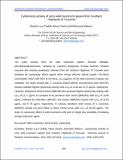| dc.description.abstract | The crude extracts from six wild mushroom species (Russula cellulata,
Afrocantharellussymoensis, Lactarius sp, Lactarius denigricans, Russula kivuensis, Amanita
muscaria and Amanita phalloides) collected from the Southern Highlands of Tanzania were
evaluated for cytotoxicity effects against Brine shrimp (Artemia salina) nauplii. The lethal
concentration which kills 50% of the larva, LC50 (μg/mL) of the wild mushroom extracts was
evaluated. The results showed that, A. muscaria ethanol (MS1E) and petroleum ether (MS1PE)
extracts exhibited highest cytotoxicity activity with LC50 of 11.00 and 13.72 μg/mL respectively.
Lactarius. denigricans ethanol extract (BM10E) also possessed highest cytotoxicity activity with
LC50 of 12.77 μg/mL as compared to its petroleum ether extract (BM10PE) with LC50 of 18.96
μg/mL, followed by chloroform (BM10C) and acetone (BM10A) extracts with LC50 of 32.56
μg/mL and 47.79 μg/mL respectively. In contrast, petroleum ether extract of A. symoensis
(BM6PE) showed non-toxic effect on Brine shrimp larvae with LC50 of 202.96 μg/mL. The
study on cytotoxicity effect of wild mushrooms will give an insight into possibility of isolating
stronger anticancer agents. | en_US |

